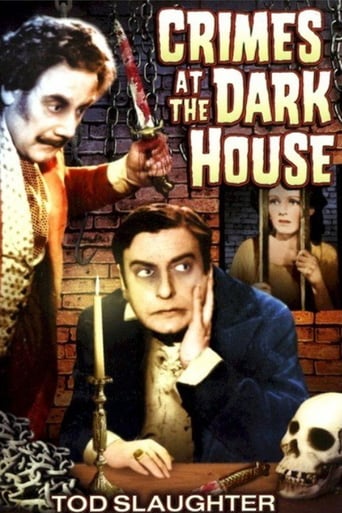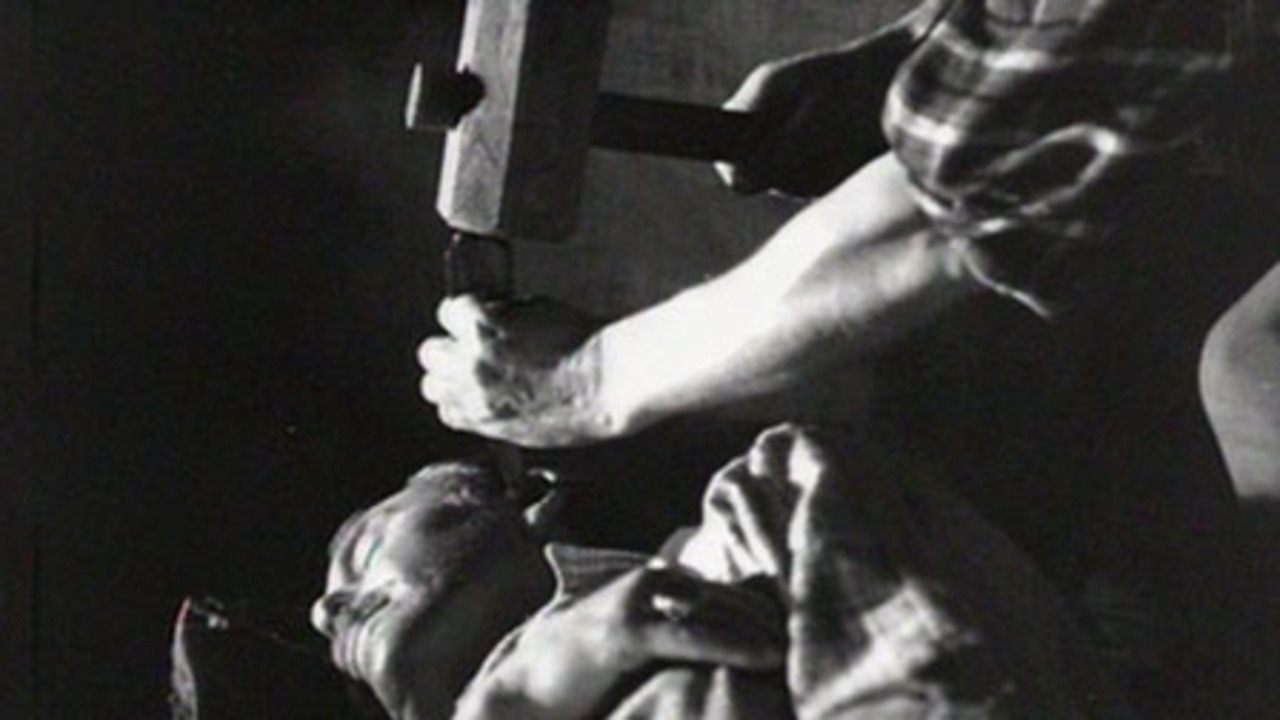JohnHowardReid
Crimes at the Dark House (1940) was adapted from the famous Wilkie Collins novel, The Woman in White. Warner Bros made an outstanding (and far more faithful) version, directed by Peter Godfrey in 1948, with Alexis Smith, Eleanor Parker and Sydney Greenstreet (which is not at present available on commercial DVD). This one was obviously filmed on the cheap. Nonetheless, despite Slaughter's fulsome melodramatics, it has its suspenseful and even horrific moments, plus a delightful interpretation (the extreme opposite of Greenstreet's) of Fosco by diminutive Hay Petrie. Geoffrey Wardwell (in his last of six movies) is a dead loss as the hero, but Sylvia Marriott manages her dual role quite ably. Stage actress Hilary Eaves also makes a considerable impression in one of her rare movies (she made only three), while Rita Grant is an absolute stand-out as the maid of no account.
chrismartonuk-1
It seems surprising - not knowing the copyright situation with Wilkie Collins original - that a quota quickie producer like George King should be able to get his hands on a respected literary source like THE WOMAN IN WHITE. However, the script rewrites the story so it is entirely told from the viewpoint of the false Sir Percival Glyde. Other adaptations might tell the tale from the viewpoint of the heroines as they struggle to unravel the mystery - but we are aware of the deception from the start as Tod creeps into a sleeping gold prospectors tent and dispatches him in a manner that suggests he's read Hamlet.The disadvantage of this approach is that the fascinating, complex characters of Collins' text are flattened to one-dimensional cyphers. Laura is as much of a shrinking violet as she is in the novel but the fascinating figure of Marion (sapphic hints well suppressed here) is sidelined for much of the time. The annoyingly-hypochondriac Mr Fairlie seems more robust and more of a stock-comic figure. But the reduction of the fascinating figure of Count Fosco to Glyde's stooge is the most grievous oversight. Fosco - a roly-poly lovable eccentric who liked dogs and sunlight - was all the more chilling for being above suspicion unlike the obviously-villainous Glyde. For all that Hay Petrie brings to the part, it's just a shadow of what it could be. Still, Petrie and Slaughter make a fine pair of rogues - a cut-rate British version of Sidney Greenstreet and Peter Lorre.What do we get in compensation for this? Two words - Tod Slaughter. His films are unique in that we get to view the story from the villain's perspective - imagine James Bond from Blofeld's viewpoint. He rises to the occasion here and is at his most lecherous - fixing his beady eyes on a comely maid whom he assigns "special duties", then strangles when she becomes inconveniently pregnant, gleefully snogging Laura upon first meeting her, and finally trying his evil way on her sister at the climax saying "I used to break precipitous horses in the Australian gold fields, and I'll enjoy breaking you!" Seldom has any villain cackled so evilly as Tod does here. Tod may start the film in an understated fashion as "Sir Percival" comes home but he's soon giving us the full melodramatic range - shifty up-to-no-good expression, comic exasperation as the bills pile up, and unashamed lechery as - convincingly sloshed on his wedding night - he ominously mounts the stairs as his squeamish bride waits fearfully in her bed. Incredibly, he is allowed to have his "wicked way" with her. Further examples of unbridled villainy include opening the window in the bedroom of the pneumonia-ridden Woman in White - having announced he expects a "change in her condition" - and luring one victim to her death saying she will, shortly, "be going on a long journey". Freddy Krueger could do with Tod's gag writers.Something just occurred to me. We never discover the true identity of Tod's character. But examine the facts. A boozy, lecherous, overweight rogue from Australia who abuses a position of social authority and whose very repellent physical presence doesn't dampen his sex-drive for the ladies - was he Sir Les Patterson?
mark.waltz
Wilkie Collin's novel "The Woman in White" has been the subject of two films and an Andrew Lloyd Webber stage musical that recently had a brief run on Broadway. It is basically a story of scandal and fraud amongst Europe's upper crust. This is the first film version, made in England during a period that many poverty row studios were making abridged versions of classic novels. Some of these, such as a British version of "Scrooge", are actually pretty good, but most of them, like "Jane Eyre", "Oliver Twist", and "The Scarlet Letter" come off as abridged versions that barely attempt to give any sort of character development. In the case of "The Woman in White", this 69 minute film goes into a little more depth than the ones listed above, but rather than being presented as a representation of the Gothic novel it was based on, it is more of a horror film made to show off the hamminess of its leading man, Tod Slaughter. As the fake Count Percival Glyde, Slaughter takes over the estate of the man he is seen brutally murdering in the first scene of the film. Slaughter sneers and laughs as he goes through his horrific actions to keep control of the status he has achieved through nefarious means. Slaughter is so over the top that he makes Charles Laughton seem subtle in comparison. His acting style is so close to camp that you can't help but laugh every time he commits a horrible crime. In the four films that I have seen of his so far, I felt that his films seem like they were meant for the silent era. His villains all seem so one dimensional of the mustache twirling school of acting. Even Bela Lugosi in his Monogram cheapies showed some underlying motivations for his criminal actions, yet Slaughter's acting is so silly you'd think you were watching a live version of cartoon characters Snidely Whiplash or Boris Badinoff. In that sense, these films are fun to watch because they are so delightfully bad, like an old silent Pearl White serial or an early 20th century stage melodrama. I wonder if Lugosi and Karloff watched these films and toned down their performances based on their reactions to his performance. It is also interesting to note that Slaughter's looks were not transfered over into the recent musical version to his character, but to Michael Crawford's (in London) and Michael Ball's (both in London and on Broadway) character of the comic villain Dr. Fosco (played here by Hay Petrie).I always thought that every Tod Slaughter movie should include that line, "You shall be a bride. A bride of death!". He first used that line on screen in "Murder in the Red Barn" and repeats it here again to a buxom parlor maid. It's sort of like Mel Brooks' constant use of the lines, "Walk this way" and "It's good to be the king!". No Tod Slaughter movie should be complete without it. In the 1940's British cinema made many technical strides that made some of their films seem almost modern in comparison to American films of that era, but many of the films made there in the 1930's seem quite creaky when compared to those made just a few years later. The 1948 Warner Brothers version had more of a Gothic style to its storytelling (and a much higher budget and well known cast), and the musical's filmed background gave the impression that the character's lives were as flat as the setting. It is interesting to have seen this story done by three different perspectives that I wonder how it would work as a film today. I had no idea that the British version of "The Woman in White" had even been made until I purchased it on DVD as part of my ongoing film study. Interesting to note that this is one of two Tod Slaughter films made that were later turned into musicals (the other is "Sweeney Todd", which a revival of ironically opened around the same time as "The Woman in White").
reptilicus
Tod Slaughter. 60 years ago he dominated British B movies, 30 years ago no one remembered him, to-day he is being re-discovered and given the respect he has always deserved. Welcome back Tod! Modern film historians compare him to Boris Karloff and while that is a nice accolade it is not entirely appropriate. If we have to compare Tod to another British screen villain I would choose Lionel Atwill. Oh yes, Boris could be menacingly evil but there was always a motivating force behind him, a drive that so obsessed him he lost sight of everything else (check out THE DEVIL COMMANDS or THE MAN WITH NINE LIVES or even BEFORE I HANG to see what I mean.) Lionel and Tod were evil for no other reason than they simply WANTED to be; they were mean and they liked it!That having been said now lets discuss this movie. You know you are in for a great time when the picture has only just begun and a killer strikes by hammering a wooden spike into the ear of a sleeping man! That killer is our Tod (what a surprise!) and he impersonates the dead man, Sir Percival Glyde, to take possession of a large inheritance. Trouble rises when Tod discovers he has inherited nothing but a big stack of bills and if he wants to avoid Debtor's Prison he'd better find a rich wife right away! Is that a problem? Not for Tod, he has set his sights on a lovely young maiden in a nearby estate. So what if she is young enough to be his daughter she is rich and who knows, she just might have an . . .er . . . "accident" not long after the wedding.This is melodrama at its best. The false Sir Percival is hardly inside his manor house before he begins canoodling with a buxom chambermaid. When she informs him that she is expecting his child he leads the gullible girl to the boat dock where he strangles her ("You wanted to be a bride? I'll make you one! A bride of Death! Heh, heh heh!") Meanwhile there is another woman hanging around who claims that Sir Percival is already married . . . to her, and they have a daughter! Honestly stealing a fortune is such a very complicated thing! Tod has to find a way to eliminate them too. Does he? You will find out. Part of the fun of watching a Tod Slaughter film is seeing just how perversely evil he can be and knowing that at the end his fate will be a fitting one; this movie does not disappoint on any level.Is this his best film? Some people say so; though my personal favourite is THE FACE AT THE WINDOW. Now sit back, imagine yourself in a British theatre back in the Victorian days and enjoy the show. Feel free to hiss the villain and cheer the hero and heroine. Enjoy!


 AD
AD


